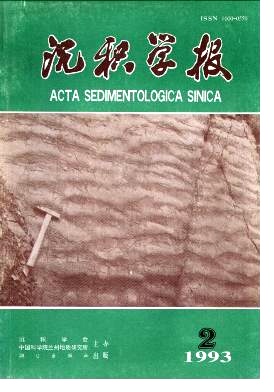Li Rihui. Trace Fossils From Middle-ordovician Jinsushan Formation, Fuping, Shaanxi and Their Depositional Environments[J]. Acta Sedimentologica Sinica, 1993, 11(2): 27-33.
| Citation:
|
Li Rihui. Trace Fossils From Middle-ordovician Jinsushan Formation, Fuping, Shaanxi and Their Depositional Environments[J]. Acta Sedimentologica Sinica, 1993, 11(2): 27-33.
|
Trace Fossils From Middle-ordovician Jinsushan Formation, Fuping, Shaanxi and Their Depositional Environments
- Received Date: 1991-05-22
- Publish Date:
1993-06-10
-
Abstract
Characteristized by hemipelagic thinly-bedded lime mudstones interbedded with limestone breccias derived from gravity flow,the Middle-Ordovician Jinsushan Formation yields abundant trace fossils,but the are not evently vertical distributed. A brief description is as followsGn ascending order): Member 1, which consists mainly of dolomits,containing no trace fossils. Member 2,which composed of dark gray thinly-bedded lime mudstone,and is characterized by a small amount of tuff,radiolarian chert and well-sorted thinly-bedded calcareite and calcisiltite which represent the equivalent of contourite. Trace fossils are rare,with only one network trace fossil(Neurodictyon n. ichnogen.) and three facies-crossing trace fossils(Chon-drites,Cochlichnus,Gordia) occuring. Member 3,which consists of thinly-bedded lime mudstones interbedded with limestone breccias and yield abundant trace fossils,which includs :Belorhaphe,Chondrties,Cochlichnus, Gordia, Helminthopsis, Helminthoida, Megagrapton, Neurodictyon, Oldliamia, Paleodictyon, Phycodes,Protopaleodictyonand squamodictyon. Member 4.whose lower part consists of dark gray thinly-bedded limestone and the upper,of marl. Like Member 2,it is also contains a small number of trace fossils. Of which,on-ly two ichnogenera-Cochlichnus and Gordia are recognized. Based on the component, relative aboundance and preservational aspect of the trace fossils, in Member 3, the Paleodictyon ichnocoenosis is established, which consists chiefly of network trace fossils represented by the ichnogenus Paleodictyon, and this ichnocoenosis is analogus to Nereites ichnofacies. It is believed that the trace fossil association of the Member 2 belongs also to Nereites ichnofacies. But its water depth may be deeper than that of the Paleodictyon ichnocoenosis and is probably up to one thousand meters. In terms of trace fossils,sedimentary characteristics well as paleontological evidences,it is suggested that the depositional environments of the Member 1 to 4 are shallow-platform, basin margin,lower foreslope,and upper foreslope respectively. As to the sharp change of depositional environments from shallow-platform to basin margin,the possible cause may attribute to the subsidence owing to the tension fracturing of the area during that period.
-
References
|
[1]
|
梅志超等,1982,石油与天然气地质,第3卷,第1期,49~56页 |
|
[2]
|
李文厚,1986,沉积学报,第四卷,第1期,34~42页 |
|
[3]
|
安太摩等,1985,地质学报,第59卷,第2期,97~108页 |
|
[4]
|
李日辉,1992,现代地质,第6卷,第2期,183~187页 |
|
[5]
|
贾振远,1988,石油与天然气地质,第9卷,第2期,171~ 177页 |
|
[6]
|
杨式博,1986,我国浊流沉积复理石相的遗迹化石及其古生态和古环境,中国古生物学会第十三、十四届学术年会论文选集,安徽科学技术出版社,143~161页 |
|
[7]
|
Bouren,D. W. and HEECEN,B. C.,1965,Science. Vol. 150,p. 60~63 |
|
[8]
|
Ceimes, T. P. and Anderson,M. M.,1985,Jourm. of Paleontol. Vol. 59,No. 2,p. 310~343 |
|
[9]
|
Ksiazkiewicz, M.,1977,Trace fossils in the flysch of the Polish Carpathians. Palaeontologica Poloni-ca. Vol. 36 p. 1~208 |
|
[10]
|
McCann,T. and Pickerill,R. K.,1988,Journ. of Paleontol. Vol. 62,p. 330~348 |
|
[11]
|
Seilacher,A.,1967,Marine Geology. Vol. 5,p. 413~429 |
|
[12]
|
Seilacher A. 1977,InT. P. Crimes and J. C. Harper (eds.):Trace fossils 2. Geolo. J. Spec. Issue 9. Seel House Press, Liverpool,p. 289~334. |
-
-
Proportional views

-






 DownLoad:
DownLoad: